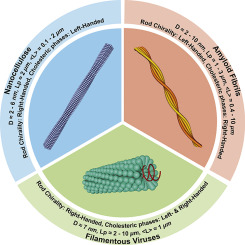Current Opinion in Colloid & Interface Science ( IF 8.9 ) Pub Date : 2018-09-12 , DOI: 10.1016/j.cocis.2018.08.004 Gustav Nyström , Raffaele Mezzenga

|
Amyloid fibrils, nanocellulose and filamentous viruses are three important families of filamentous biological colloids exhibiting a rich phase behavior in two and three dimensions. Similarly to the entropy-driven crystallization of hard spheres into crystals, also in their case entropy triggers order-order transitions at increasing concentrations, but their high aspect ratio, semiflexible and chiral nature bring additional complexity to the phase diagram and in some case, system-specific features. Some of the differences among these three classes of filamentous colloids arise from their own constitutive nature and their mesoscopic structure; however, other features are universally shared among them and can be understood by applying general liquid crystal theories in bulk or confined geometries. In this manuscript we review the main analogies and differences among these three classes of biological filamentous colloids, starting from a discussion on their chemical composition and progressing across length scales to discuss first their mesoscopic structure and then their colloidal behavior, with particular emphasis to their lyotropic liquid crystalline features. By doing so, we highlight the main tools available to tune the colloidal properties, from the onset of the isotropic-nematic transition and the width of its biphasic region, to the shape transformations and director field distribution in the ensued liquid crystalline droplets, to the way chirality is transferred from the constitutive colloidal particles to the final macroscopic liquid crystalline phases.
中文翻译:

液晶丝状生物胶体:类比和差异
淀粉样蛋白原纤维,纳米纤维素和丝状病毒是丝状生物胶体的三个重要家族,在二维和三维中表现出丰富的相行为。与熵驱动的硬球结晶为晶体相似,在它们的情况下,熵也会触发浓度增加时的阶跃转变,但是它们的高长宽比,半柔韧性和手性性质给相图以及在某些情况下的系统带来了额外的复杂性特定的功能。这三类丝状胶体之间的某些差异是由于它们本身的本构性质和介观结构引起的。然而,其他特征在它们之间是普遍共享的,并且可以通过以块状或有限的几何形状应用一般的液晶理论来理解。在这篇手稿中,我们将对这三类生物丝状胶体的主要类比和差异进行综述,从它们的化学组成的讨论开始,并逐步研究其长度范围,首先讨论它们的介观结构,然后讨论它们的胶体行为,并特别强调其溶致性。液晶特征。通过这样做,我们重点介绍了可用于调节胶体性质的主要工具,从各向同性-向列相转变的开始及其双相区的宽度,到随后的液晶小滴中的形状转变和指向矢场分布,再到手性从组成型胶体颗粒转移到最终的宏观液晶相的方式。从对它们的化学组成的讨论开始,并逐步发展到长度范围,首先讨论它们的介观结构,然后讨论它们的胶体行为,并特别强调其溶致液晶特性。通过这样做,我们重点介绍了可用于调节胶体性质的主要工具,从各向同性-向列相转变的开始及其双相区的宽度,到随后的液晶小滴中的形状转变和指向矢场分布,再到手性从组成型胶体颗粒转移到最终的宏观液晶相的方式。从对它们的化学组成的讨论开始,并逐步发展到长度范围,首先讨论它们的介观结构,然后讨论它们的胶体行为,并特别强调其溶致液晶特性。通过这样做,我们重点介绍了可用于调节胶体性质的主要工具,从各向同性-向列相转变的开始及其双相区的宽度,到随后的液晶小滴中的形状转变和指向矢场分布,再到手性从组成型胶体颗粒转移到最终的宏观液晶相的方式。特别强调其溶致液晶特性。通过这样做,我们重点介绍了可用于调节胶体性质的主要工具,从各向同性-向列相转变的开始及其双相区的宽度,到随后的液晶小滴中的形状转变和指向矢场分布,再到手性从组成型胶体颗粒转移到最终的宏观液晶相的方式。特别强调其溶致液晶特性。通过这样做,我们重点介绍了可用于调节胶体性质的主要工具,从各向同性-向列相转变的开始及其双相区的宽度,到随后的液晶小滴中的形状转变和指向矢场分布,再到手性从组成型胶体颗粒转移到最终的宏观液晶相的方式。



























 京公网安备 11010802027423号
京公网安备 11010802027423号